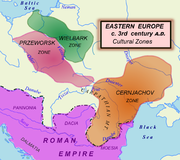
Carpathian Tumuli
Encyclopedia

Lipiţa culture
Lipiţa culture is the archaeological material culture representative of a Dacian tribe. It took its name from the Ukrainian village of Verkhnya Lypytsya Lipiţa culture (Romanian Lipiţa, Polish Lipica other spellings: Lipitsa, Lipitza) is the archaeological material culture representative of a...
, the Carpathian Tumuli culture evolved in parts of today’s Pokuttya
Pokuttya
Pokuttya or Pokuttia is a historical area of East-Central Europe, between upper Prut and Cheremosh rivers, in modern Ukraine. Historically it was a culturally distinct area inhabitated by Ukrainians and Romanians on the previously unpopulated borderlands between the lands of Lviv and Halych...
, Maramureş
Maramures
Maramureș may refer to the following:*Maramureș, a geographical, historical, and ethno-cultural region in present-day Romania and Ukraine, that occupies the Maramureș Depression and Maramureș Mountains, a mountain range in North East Carpathians...
, Bucovina and to a lesser extent, Northwest Moldova
Moldova
Moldova , officially the Republic of Moldova is a landlocked state in Eastern Europe, located between Romania to the West and Ukraine to the North, East and South. It declared itself an independent state with the same boundaries as the preceding Moldavian Soviet Socialist Republic in 1991, as part...
and evolved between the end of the 2nd century and the end of the 4th century AD.
Arrival of East Germanic tribes
East Germanic tribes
The Germanic tribes referred to as East Germanic constitute a wave of migrants who may have moved from Scandinavia into the area between the Oder and Vistula rivers between the years 600 and 300 BC. Later they went to the south...
in the Upper Dniester
Dniester
The Dniester is a river in Eastern Europe. It runs through Ukraine and Moldova and separates most of Moldova's territory from the breakaway de facto state of Transnistria.-Names:...
region forced Costoboci
Costoboci
The Costoboci were an ancient people located, during the Roman imperial era, between the Carpathian Mountains and the river Dniester.The Costoboci invaded the Roman empire in AD 170 or 171, pillaging its Balkan provinces as far as central Greece, until they were driven out by Romans...
to withdraw or crowd in the Carpathians at the end of the 2nd century AD and the beginning of the 3rd, where a part of them were already living. Other groups migrated in the area of the Carpic culture (nowadays Moldova) or remained to live together with the newly arrived peoples of the Przeworsk culture
Przeworsk culture
The Przeworsk culture is part of an Iron Age archaeological complex that dates from the 2nd century BC to the 5th century AD. It was located in what is now central and southern Poland, later spreading to parts of eastern Slovakia and Carpathian Ruthenia ranging between the Oder and the middle and...
.
Dacian
Dacians
The Dacians were an Indo-European people, very close or part of the Thracians. Dacians were the ancient inhabitants of Dacia...
mark of the culture is showed by most of the material evidence. It is obvious that tumuli disappear from Roman Dacia
Roman Dacia
The Roman province of Dacia on the Balkans included the modern Romanian regions of Transylvania, Banat and Oltenia, and temporarily Muntenia and southern Moldova, but not the nearby regions of Moesia...
with the coming of Imperial administration, but they continue to exist in the unconquered north of Dacia, a sign that the local population keeps its ancestral beliefs. The demarcation line is pretty sure, since now neighbour Przeworsk peoples don’t have tumular tombs. As in the Lipiţa culture, the dead were cremated and their ashes were put in urns which were buried in the tumuli. The difference is that now we don’t find anymore plane tombs, but only or almost only tumular tombs.
After Theodosius I
Theodosius I
Theodosius I , also known as Theodosius the Great, was Roman Emperor from 379 to 395. Theodosius was the last emperor to rule over both the eastern and the western halves of the Roman Empire. During his reign, the Goths secured control of Illyricum after the Gothic War, establishing their homeland...
defeats the neighbouring Carpi in 381, the people of the Carpathian Tumuli culture lose an important ally and soon after, this archaeological culture dissipates, its place being taken by another one, Sîntana de Mureş – Chernyakhov
Chernyakhov culture
The Sântana de Mureș–Chernyakhiv culture is the name given to an archaeological culture which flourished between the 2nd and 5th centuries in a wide area of Eastern Europe, specifically in what today constitutes Ukraine, Romania, Moldova, and parts of Belarus...
, which replaces also the cultural aspect Poieneşti – Lucaşevca in the Northwestern Moldavian Subcarpathians, formed by the Germanic tribe of Bastarnae
Bastarnae
The Bastarnae or Basternae were an ancient Germanic tribe,, who between 200 BC and 300 AD inhabited the region between the eastern Carpathian mountains and the Dnieper river...
between the Costoboci and the Carpi.
We can follow the Costoboci even after the beginning of the 5th century, the new formed Prague - Korchak culture
Korchak culture
Korchak culture is an archaeological culture of the sixth and seventh century East Slavs who settled along the southern tributaries of the Pripyat River and from the Dnieper River to the Southern Bug and Dniester rivers, throughout modern day northwestern Ukraine and southern Belarus...
culture being linked to the Carpathian Tumuli, and less Slavic. Between the two cultures was no chronological breach; Costoboci remained on their territories, but now start to receive not only Slavic-type material culture elements, but also some Slavic population.

